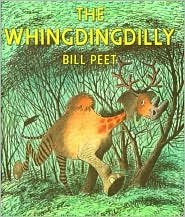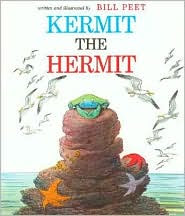After so many book reviews, I realized that I am often spending a few paragraphs talking about the illustrators who do the cover art (and, if you're lucky enough, interior pictures as well of) the books I am reviewing. Because almost all of the artists I talk about are also picture book illustrators and often authors in their own right, I thought I'd dedicate one post to them, A Brief List of Excellent Picture Book Illustrator/Authors, and this post on why I think reading picture books is an important and vital act at any age and stage of childhood.
Picture books are the gateway to a life long love of reading and, hopefully, even an appreciation of art. There is definitely more quantity than there is quality in the world of picture books these days, especially if you count all of the paperback television and movie related books that take up so much shelf space at the bookstore. If we keep the discussion strictly to traditional picture books, those that are released in hardcover initially and, if they sell well, in paperback a year or two later, that narrows the field a bit. Within this range, there are picture books that can be read by emerging readers instead of the sometimes dull beginning to read titles published especially for emerging readers. For a list of a few picture books that fit this bill, check out my post on Really Great Picture Books for Very Early Readers. For suggestions on sets and series published with the intention of teaching emerging readers, check out my post, The Beginning Reader Dilemma.


But, picture books aren't just for children who are learning to read. In fact, there are some picture books that are classified as fifth grade reading level or higher by some formulas that calculate this kind of thing. Among picture book with this distinction are those by two of my favorites, Bill Peet and William Steig. Both of these author/illustrators have brilliant and uniquely different story telling and illustration styles. Peet's stories are almost Norman Rockwell like in their (sometimes) depictions of a slice of Americana. Themes in his works include circuses, trains and always animals. Peet's illustrated autobiography, Bill Peet: An Autobiography won the Caldecott Honor in 1990. In it, he wrote of his years working for and directly with Walt Disney as a storyman and story board illustrator for almost every classic Disney movie from Peter Pan to Sword in the Stone. Some of the Disney influence can be seen in Peet's books. However, Peet is his own story teller and he has a wonderful sense of right and wrong and good and bad and thiscomes through in his books but is never dogmatic. He often tells stories about characters who learn to enjoy the lives they have, or, even better, grow to love the lives they live. One of my favorite Peet books, as a child and adult, is Kermit the Hermit, which tells the story of a misanthropic crab who, after being rescued by a young boy, decides to repay the kindness. Kermit's transformation and how he does it make for a great read.
In addition to circuses, trains and animals, a love of Peet's is the environment and is demonstrated in his books, Farewell to Shady Glade, which he dedicated to pioneering environmentalist, Rachel Carson, and The Wump World, which, though written in 1970, reads a lot like the script to Pixar's Wall - e. The length and vocabulary, as well as the developed plots in Peet's books are what bump them up to a higher reading level than most picture books and make them appealing to children young and old.
Winner of the Caldecott Medal for the classic, Sylvester and the Magic Pebble, William Steig's picture books have an even more unique and remarkable vocabulary (like the word "gimcrack," which, while you'll get the meaning from the context might have you thumbing through a dictionary nonetheless) than Bill Peet's although they tend to be a bit shorter on text. Steig's characters, most often of the animal variety just like Peet's, often face mortal peril, usually at the hands (or paws) of other villainous animals and must use and must use their wits, or sometimes luck, and even a little bit of magic at times, to escape and return home to their loving families. I think my favorite of all Steig's picture books has to be Spinky Sulks, about a boy who is angered by something his older brother says (he corrects a geographical error of Spinky's) and is thrown into a monumental sulk. This sulk cannot be undone by apologies, crullers, a visit from Grandma or even the circus. Finally, Spinky sees the error of his ways and, undercover of night, prepares a breakfast feast for his family.
Steig manages to capture the truth of relationships between human beings, their ups and the downs, and his characters, even when they are children, are portrayed as equals - equally capable of mistakes and finding solutions and helping themselves out of a mess. They are not talked down to by the adults, nor are they considered helpless creatures that need coddling. And, above all, Steig manages to portray the deep and abiding love between parent and child, brother and sister, husband and wife, in all of his stories.
You may not know that the movie franchise, Shrek, is based on a picture book by William Steig written in 1990. And yes, the talking donkey was Steig's original idea. One of Steig's last books before he died in 2003 is also one of my favorites by him. It is short, simple and very sweet. Pete is having a bad day because it is raining and he can't go outside to play with his friends. In an attempt to cheer him up, Pete's father pretends to make Pete into a pizza, rolling the dough, sprinkling it with cheese and baking it. Pete and his mom play along and by the time the pizza is done, the sky has cleard and Pete runs out to play. This is a great book because, if the listeners are little enough, you can make them into pizzas as you read! Steig is also the recipient of a Newbery Honor for the amazing Abel's Island. Short in length but profound in it's examination of the development of character that occurs in Abel over the course of the story. With animals as main characters, it is a great read out loud for young children, despite the philosophical nature of the story. I highly recommend it to all families who enjoy reading together. In many schools, it is required reading for the fifth grade.
There are many, many wonderful, valuable picture books on the shelves. I chose to focus on the works of Bill Peet and William Steig here to point out the ways in which a picture book can be a complex, engaging story in which characters develop and grow over the course of the story. I hope that I have inspired those of you with older children - my eleven and sixteen year olds still jump into my bed for a good story now and then - to keep reading picture books out loud to your kids. The right ones are out there. And, if you can't grab the big kids there are definitely enough books to hook the little ones.
0 comments:
Post a Comment